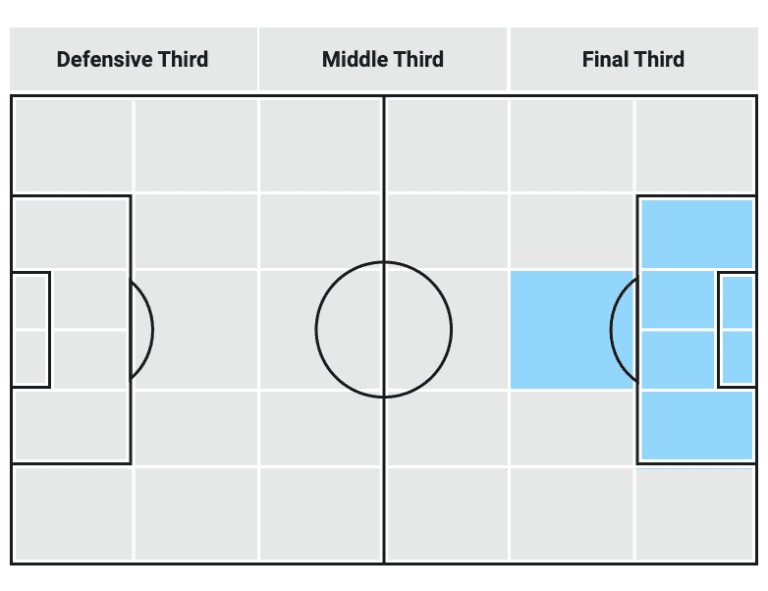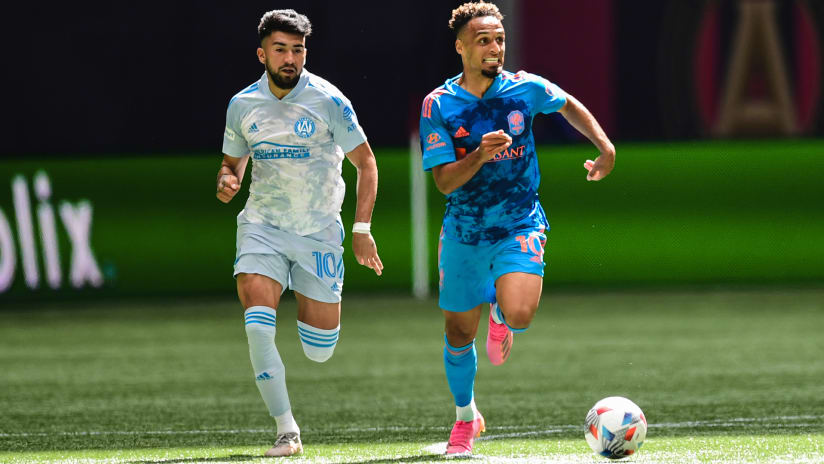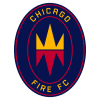As the Seattle Sounders and Austin FC finished up their 0-0 draw on Sunday night, MLS officially began its multi-week break for the June international window.
The first leg of this season has been a whirlwind, complete with a new team entering the league, a new stadium opening, new coaches developing their teams, new signings and so much more.
But let’s take a minute and take a breath, shall we? Let’s take a step back and try to sort out some of the things we’ve learned from the opening fifth of the season. To do that, I’m spotlighting one Second Spectrum statistic for each team that gives us at least some insight into their season so far. This week we’ll run through the 14 teams in the Eastern Conference, while next week we’ll look at all 13 teams out West.
Fourteen teams, 14 stats. It’s go time.
33.1 seconds per possession
Under Gabriel Heinze, Atlanta United have very quickly become known for one thing: their commitment to controlling possession. They’ve averaged at least 56% possession in all seven of their games and spend more time on the ball per possession (33.1 seconds) than any team in MLS by nearly three seconds. After the international break, it will be up to Heinze to see if he can help turn that possession into goal-scoring opportunities. Right now, Atlanta United are 22nd in MLS in xG per 90 minutes (0.91).
17 turnovers via sloppy touches in their defensive third
Chicago want to use the ball to break opposing teams down – and to be fair to them, they’ve had some lovely possession moments this year.
They also rank 13th in xG this season, which is squarely in the middle of the pack. But Chicago’s excessive number of touches that lead to turnovers in their own defensive third (17, which is the joint-most along with LAFC and Austin) limits their ability to move the ball forward and score goals.
20.5 shots allowed per game
While their attacking personnel looks different this season, FC Cincinnati still struggle to contain opposing attacks. They’ve allowed 20.5 shots per game this season, which is nearly three shots per game more than any other team in MLS. However, it’s not all bleak for Cincinnati: they’ve only allowed 0.095 xG per shot, which is 14th best in the league. That’s not an incredible comfort, but setting your team up to concede low-quality chances while you reevaluate your overall defensive structure isn’t a terrible thing.
16.244 fewer passes per game into key attacking zones in 2021 than in 2020
Caleb Porter’s Columbus Crew are in the middle of a major offensive regression. They’ve won their last two games, but Columbus aren’t creating chances at the same clip as they did last year (they averaged 1.18 xG per game in 2020, as compared to 0.62 this year). A big issue with the Crew’s possession play right now is their lack of passes into these highlighted zones:

Columbus currently average 34.714 passes into those zones per game, which is down by more than 16 passes from their 2020 total. To start scoring goals after the break, Columbus need to target those zones much more frequently.
214 team presses
They’re not at the top of the Eastern Conference table, but Hernan Losada has D.C. United playing his way over their first eight games of the season. Through those eight games, D.C. have registered 214 team presses, which Second Spectrum defines as “a coordinated series of pressures by two or more defenders.” The only two teams that have more team presses this season are Sporting Kansas City and the New York Red Bulls. D.C. United are a heavy metal band now, y’all.
2.8 passes leading to a shot per 90 minutes
If 2.8 passes that lead to a shot per 90 minutes sounds low, well, that’s because it is. That 2.8 figure isn’t Miami’s team-wide shot-creating passes number. It’s Federico Higuain’s number. The elder Higuain brother leads Inter Miami in shot-creating passes per 90 and has been a key piece of Phil Neville’s struggling attack (Miami are 22nd in xG per 90 this season with just 0.91).
After eight games, Inter Miami find themselves in an uncomfortable spot: their attack hinges on a 36-year-old playmaker.
21 center back dribbles
Sitting fifth in the East, Wilfried Nancy has Montréal in a strong position heading into the break. A significant part of Nancy’s tactical approach has been establishing a three-center back shape that both anchors the defense and provides opportunities for those center backs to initiate attacks. With central defenders like Kamal Miller able to drive forward with the ball, Montréal are third in MLS with 21 dribbles from center backs this season.
19.73 crosses per 90 minutes
Nashville don’t mess around. When they have the ball, they know exactly what they’re supposed to do with it: move it forward and cross it into the box for any able-bodied attacker to direct on frame. Gary Smith’s team is averaging 19.73 crosses per 90 minutes in 2021, which is more than any other team in MLS. Though relying on crosses as one of your main attacking methods may seem risky, Nashville are putting their crosses to good use. They’ve generated the second most xG from crosses (3.8) so far this year, only behind the New England Revolution.
3.9 xA
I wrote about it last week, but it bears repeating: Carles Gil has been the best playmaker in MLS this year. He leads all MLS players in expected assists (3.9), leads the league in shot-creating passes (66) and is tied for the lead in successful through balls (11). He also just generally terrifies opposing defenses.
Gil is the major reason why the Revolution have a three-point lead at the top of the Eastern Conference heading into the break.
10.29% of their game is spent in the “attacking phase”
Though NYCFC don’t get as much credit for their attacking play under Ronny Deila as they did under Patrick Vieira and Dome Torrent, Deila lets his team go to work in the attacking half. No team in the Eastern Conference spends as much of their time in the attacking phase as NYCFC’s 10.29%.
How do you define the “attacking phase”? I’ve let Second Spectrum do that for me. They say that the attacking phase “typically occurs when the offensive team is driving toward the penalty area, dribbling or passing, with the intention of getting a shot off.” NYCFC have done a lot of that this year.
48.8% success rate on pressures in the final third
If D.C. United are a new, hip heavy metal band, the New York Red Bulls have put out a bunch of heavy metal albums and toured the United States 10 times over. Gerhard Struber has his team playing the Red Bull way, high pressing out of a 4-4-2 diamond shape. Their press isn’t especially notable – everybody knows it’s coming. The notable thing is the effectiveness of their press. RBNY successfully win the ball on 48.8% of their final-third pressures, which is the highest percentage in MLS.
0.881 xG allowed per 90 minutes
While Oscar Pareja’s Orlando City aren't lighting MLS on fire with their attacking play, their defensive work has been excellent through seven games. They’ve only allowed 0.881 xG per 90 minutes, which is the sixth-stingiest tally in the league. Orlando have also only allowed 0.082 xG per shot, which is seventh-best in MLS. Getting even more specific, Orlando are especially comfortable when they’re back in a set defensive block. They’ve only allowed 0.503 xG per 90 minutes this season when they’re in an organized defensive shape, which is the fifth-best in MLS.
162 tackles attempted by their central midfielders
Jim Curtin’s midfield diamond can fly. The Union aren’t having the strongest defensive season (they’re 18th in MLS in xG allowed with 9.7), but they do cause havoc in central midfield. Through the first stretch of 2021, no team’s central midfielders have put in more tackles than the 162 compiled by Philadelphia's midfield group. With a starting midfield of Jose Martinez, Leon Flach, Alejandro Bedoya and Jamiro Monteiro, nobody in MLS wants to face off against the Union’s diamond.
132.6 off-ball runs per game
Playing without Alejandro Pozuelo, Chris Armas’ Toronto FC have looked stagnant offensively. They’ve generated the seventh-fewest xG and the sixth-fewest shots per game in the league. It’s not just Pozuelo’s absence that’s limiting Toronto’s attack, as their lack of off-ball runs hurts their goal-scoring chances. Toronto have only put together 132.6 off-ball runs per game, which is the sixth-fewest in MLS. And that 132.6 number is down from 172.3 off-ball runs per game last year. Things need to start moving in Toronto.



























